历史
Inauguration
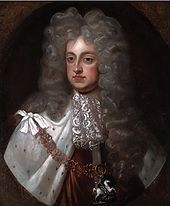
King George II, founder and president of the university
In 1734, King George II of Great Britain, and the Elector of Hanover, gave his Prime Minister, Gerlach Adolph von Münchhausen, the order to establish a university in Göttingen to propagate the ideas of academic freedom and enlightenment at the times of the European Enlightenment.
18 – 19 centuries
Throughout the 18 century the University of Göttingen was in the top rank of German universities for its free spirit and atmosphere of scientific exploration and research. By 1812, Göttingen had become an internationally acknowledged modern university with its library of more than 250,000 volumes. Napoleon had studied law here and remarked that "Göttingen belongs to the whole Europe".
In the first years of the University of Göttingen it became known for its faculty of law. In the 18 century Johann Stephan Pütter, the most prestigious scholar of public law at that time, taught jus publicum here for half a century, which had attracted students such as Klemens Wenzel Lothar von Metternich, later diplomat and Prime Minister of Austria, and Wilhelm von Humboldt, who later set up the University of Berlin. In this period Arthur Schopenhauer, the German philosopher best known for his work The World as Will and Representation, became a student at the University of Göttingen in 1809, where he studied metaphysics and psychology under Gottlob Ernst Schulze, who advised him to concentrate on Plato and Kant.
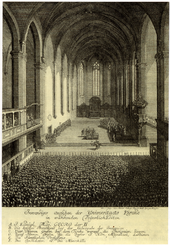
King George II in the Pauliner Church in 1748
By 1837, when the university was a hundred years old, the University of Göttingen was known as the "university of law" because the students enrolled by the faculty of law often made up more than half of all students on campus. Göttingen became a mecca for the study of public law in Germany. Heinrich Heine, the famous German poet, studied law and was awarded Dr.iur..
However, political disturbances, in which both professors and students were implicated, lowered the attendance to 860 in 1834. The expulsion in 1837 of the seven professors - Die Göttinger Sieben - viz, the Germanist, Wilhelm Eduard Albrecht (1800-1876); the historian, Friedrich Christoph Dahlmann (1785-1860); the orientalist, Georg Heinrich August Ewald (1803-1875); the historian, Georg Gottfried Gervinus (1805—1875); the physicist, Wilhelm Eduard Weber (1804-1891); and the philologists, the brothers Jakob Grimm (1785-1863), and Wilhelm Grimm (1786-1859), for protesting against the revocation by King Ernest Augustus I of Hanover of the liberal constitution of 1833, further reduced the prosperity of the university. Prior to this, the Brothers Grimm had taught here and compiled the first German Dictionary.
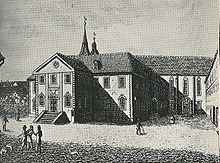
The old Building of the University and its library in 1815
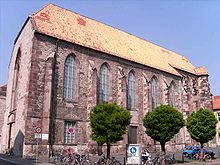
The Pauliner Church, once the seat of the University Library where Heinrich Heine, Brothers Grimm and Goethe had worked
Thereafter, Gustav von Hugo, the forerunner of the historical school of law, and Rudolf von Jhering, a jurist who created the theory of "culpa in contraendo" and wrote Battle for Right, taught here in the 19 century and maintained the reputation of the faculty of law. Otto von Bismarck, the main creator and the first Chancellor of the second German Empire, had also studied law in Göttingen in 1833, he and lived in a tiny house on the "Wall" (according to oral tradition, he lived there because his rowdiness had caused him to be banned from living within the city walls), now known as "Bismarck Cottage".
Göttingen also had a focus on natural science, especially mathematics. Carl Friedrich Gauss taught in the 19 century here in Göttingen. Bernhard Riemann, Johann Peter Gustav Lejeune Dirichlet and a number of significant mathematicians made their contribution to mathematics here. By the end of the 19 century David Hilbert and Felix Klein had attracted mathematicians from around the world to Göttingen, which made Göttingen a world mecca of mathematics at the beginning of the 20 century.
End of the 19 century – beginning of the 20 century
During this period, the University of Göttingen achieved its academic peak.
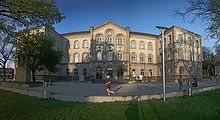
The old Auditorium Maximum (built in 1826-1865)
In 1903, its teaching staff numbered 121 and its students 1529. Ludwig Prandtl joined the university in 1904, and developed it into a leader in fluid mechanics and in aerodynamics over the next two decades. In 1925, Prandtl was appointed as the director of the Kaiser Wilhelm Institute for Fluid Mechanics. Many of Prandtl's students went on to make fundamental contributions to aerodynamics.
To date, 45 Nobel Prize laureates have studied, taught or made contributions here. Most of these prizes were given in the first half of the 20 century, which was called the "Göttingen Nobel prize wonder".
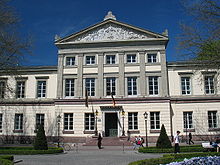
Alte Aula (
Great Hall), also Karzer, at Wilhelmsplatz (built in 1835-1837)
Social studies and the study of humanities continued to flourish. Edmund Husserl, the philosopher and known as the father of phenomenology, taught here. Max Weber, the sociologist studied here for one term.
The "great purge" of 1933
In the 1930s, the university became a focal point for the Nazi crackdown on "Jewish physics", as represented by the work of Albert Einstein. In what was later called the "great purge" of 1933, academics including Max Born, Victor Goldschmidt, James Franck, Eugene Wigner, Leó Szilárd, Edward Teller, Emmy Noether, and Richard Courant were expelled or fled. The legacy of greatness in mathematics, a lineage which had included Carl Friedrich Gauss and Bernhard Riemann, was broken.
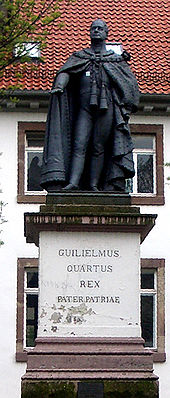
The Monument of King William IV who bequeathed Aula to the university in 1837
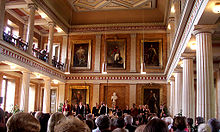
The interior of the university Aula
Though David Hilbert remained, by the time he died in 1943, the Nazis had essentially gutted the university, since many of the top faculty were either Jewish or had married Jews. Most of them fled Nazi Germany for places like the United States, Canada, the United Kingdom, and Ireland. About a year after the purge, Hilbert attended a banquet and was seated next to the new Minister of Education, Bernhard Rust. Rust asked, "How is mathematics in Göttingen now that it has been freed of the Jewish influence?" Hilbert replied, "Mathematics in Göttingen? There is really none any more" (Reid, 205). Today, Göttingen has a respectable, but no longer a world-famous, mathematics department.
Renovation after War
After World War II, the University of Göttingen was the first university in the western Zones to be re-opened under British control in 1945. Jürgen Habermas, a German philosopher and sociologist, pursued his study here in Göttingen. Later, Richard von Weizsäcker, the former President of Germany, earned his Dr.Jur. here. Gerhard Schröder, the former Chancellor of Germany, also graduated from the school of law here in Göttingen, and he became a lawyer thereafter.
Current Status
Today the university consists of 13 faculties and about 24,000 students are enrolled. More than 2,500 professors and other academics work at the University, assisted by a technical and administrative staff of over 10,000. The post-war expansion of the University led to the establishment of a new, modern 'university quarter' in the north of the town. The architecture of the old university can still be seen in the Auditorium Maximum (1826/1865) and the Great Hall (1835/1837) on the Wilhelmsplatz.
Faculties
Logo of the Faculty of Theology, Faculty 网址
|
Logo of the Faculty of Law, Faculty 网址
|
Logo of the Faculty of Philosophy (including History, Philology, etc.), Faculty Website: [1]
|
Logo of the Faculty of Medicine, Faculty 网址
|
Faculty of Mathematics (including Computer Science), Faculty 网址
|
Faculty of Physics with new observatory, Faculty Website:[2]
|
Faculty of Chemistry, Faculty Website:[3]
|
Faculty of Biology(including Psychology), , Faculty Website:[4]
|
Faculty of Geo-sciences, Faculty Website:[5]
|
Logo of the Faculty of Agriculture, Faculty Website:[6]
|
Logo of the Faculty of Forestry, Faculty 网址
|
Faculty of Social Science, Faculty Website:[7]
|
Faculty of Economics, Faculty Website:[8]
|
Associated Institutions
The university is organizationally and personally interlinked with the following independent and semi-independent institutions. There are four Max Planck Institutes situated in Göttingen:
- Max Planck Institute for Biophysical Chemistry (Karl Friedrich Bonhoeffer Institute)
- Max Planck Institute for Experimental Medicine
- Max Planck Institute for Dynamics and Self-Organization, formerly Max Planck Institute for Flow Research
- Max Planck Institute for the Study of Religious and Ethnic Diversity, formerly Max Planck Institute for History
Besides, the *Max Planck Institute for Solar System Research, formerly Max Planck Institute for Aeronomy is closely linked and has cooperation with the university.
Library
Closely linked with the university is the Göttingen State and University Library (German: Niedersächsische Staats- und Universitätsbibliothek Göttingen, or SUB Göttingen; English short form: Goettingen SUB). With its more than 4 million volumes and precious manuscripts, the library is designed for Göttingen University as well as the central library for the German State of Lower Saxony (with its central catalogue) and for the Göttingen Academy of Sciences, originally founded as the 'Royal Society for Sciences'.

New library building and "Raumskulptur" sculpture
Research
Four research institutes of the Max Planck Society for the Promotion of Science are located in Göttingen, which are associated and have maintained cooperation with the University of Göttingen. They are Max Planck Institute for the Study of Religious and Ethnic Diversity, Max Planck Institute for Dynamics and Self-Organization, Max Planck Institute for Biophysical Chemistry, and Max Planck Institute for Experimental Medicine.

Traditional Observatory of the University
Gardens
- The university maintains three botanical gardens: the Alte Botanische Garten der Universität Göttingen, the Neuer Botanischer Garten der Universität Göttingen, and the Forstbotanischer Garten und Pflanzengeographisches Arboretum der Universität Göttingen.
People
Main article: List of Georg-August University of Göttingen people
Apart from the academics already mentioned, notable people that have studied and taught at Georg-August University include the American banker J. P. Morgan, the seismologist Beno Gutenberg, the endocrinologist Hakaru Hashimoto, who studied there before World War I, and several notable Nobel laureates like Max Planck and Werner Heisenberg.
Carl Friedrich Gauss, mathematician
|
Bernhard Riemann, mathematician
|
David Hilbert, mathematician
|
Felix Klein, mathematician
|
Peter Gustav Lejeune Dirichlet, mathematician
|
|
J. Robert Oppenheimer, physicist
|
|
|
|
|
|
Arthur Schopenhauer, philosopher
|
Rudolf von Jhering, jurist
|
Otto von Bismarck, "Iron Chancellor" of the second German Empire
|
Richard von Weizsäcker, former President of Germany
|
Gerhard Schröder, former Chancellor of Germany
|
|
|
Jürgen Habermas, sociologist
|
John von Neumann, mathematician
|
Tradition
The most famous tradition of the university is that every PhD student who has just passed her/his rigorosum (oral doctoral test) shall sit in a wagon - decorated with flowers and balloons and accompanied by relatives and friends, drive around the inner city and arrive at the Marktplatz - the central square where the old town hall and the Gänseliesel statue are located. The "newly born doctor" shall climb up to the statue of Gänseliesel (a poor princess in an old fairy tale who was compelled to keep geese by a wicked woman and later regained her identity), kiss the Gänseliesel and give bouquets to her.
Campus life
There is an old saying about life in Göttingen, still inscribed in Latin nowadays on the wall of the entrance to the Ratskeller (the restaurant located in the basement of the old town hall): Extra Gottingam non est vita, si est vita, non est ita (There is no life outside Göttingen. Even if it is life, it is no life like here).
"Ancient university towns are wonderfully alike. Göttingen is like Cambridge in England or Yale in America: very provincial, not on the way to anywhere - no one comes to these backwaters except for the company of professors. And the professors are sure that this is the centre of the world. There is an inscription in the Rathskeller there which reads 'Extra Gottingam non est vita', 'Outside Göttingen there is no life'. This epigram, or should I call it epitaph, is not taken as seriously by the undergraduates as by the professors."(Bronowski, 1973, The Ascent of Man, p. 360)
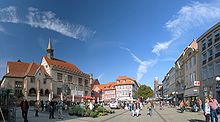
Gänseliesel fountain and pedestrian zone
The university is spread out in several locations around the city: The central university complex with the main library and Mensa (dining hall) is located right next to the inner city and comprises the faculties for Theology, Law, Economics/Business Administration and Linguistics. The departments of Ancient History, Classics, various languages, and Psychology are nearby. Elsewhere in the city are the departments of Anthropology, Mathematics and Educational Sciences as well as the Medical Faculty with its associated hospitals.
Just north of the city a new scientific center has been built in which most of the natural sciences (Chemistry, Microbiology, Plant Pathology, Agronomy, Forestry, Geology, Physics, Computer Science and, starting in the year 2010, Mathematics) are now located, including the GZMB. Other institutes are set around the inner city.
The University offers eight snack shops and six Mensas serving lunch at low prices for the students. One Mensa also provides dinner for students.
更多
- Göttingen
- Göttinger Digitalisierungszentrum
- Nobel laureates by university affiliation
- Education in Germany
- List of universities in Germany
- List of forestry universities and colleges
Notes and 参考文献
- ^ Universität Göttingen (October 05, 2009). "Leitbild für Alumni Göttingen". http://www.uni-goettingen.de/de/78400.html. Retrieved October 05, 2009.
- Hilbert, Constance Reid, Springer, April 1996, ISBN 0387946748. (biography)
External links
 |
Wikimedia Commons has media related to:
Georg-August-Universität Göttingen (category)
|
- University home page
- The "Göttingen Nobel prize wonder"; the 44 Nobel prize laureates affiliated with Göttingen
- Shame at Göttingen, detailing the 1933 purge.



